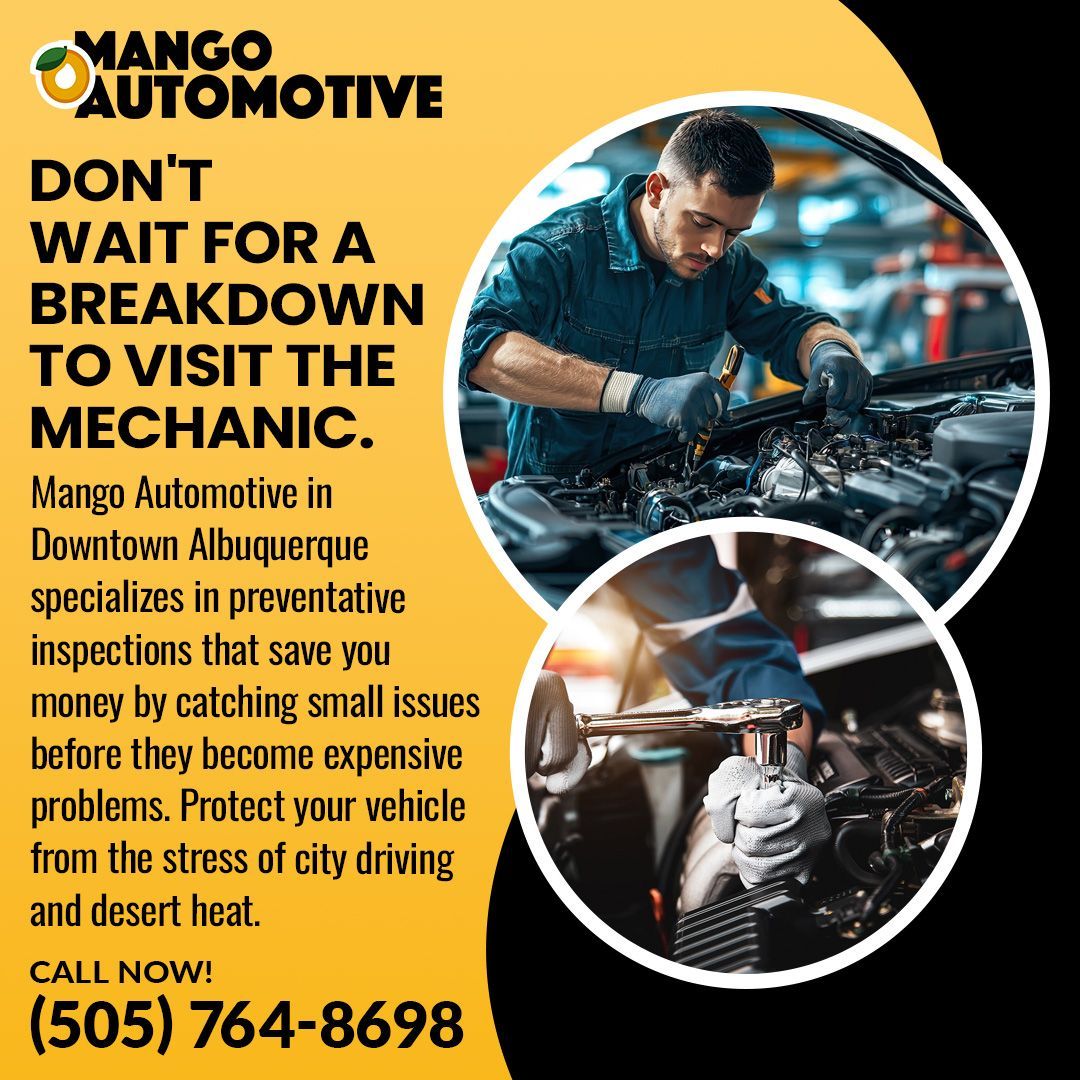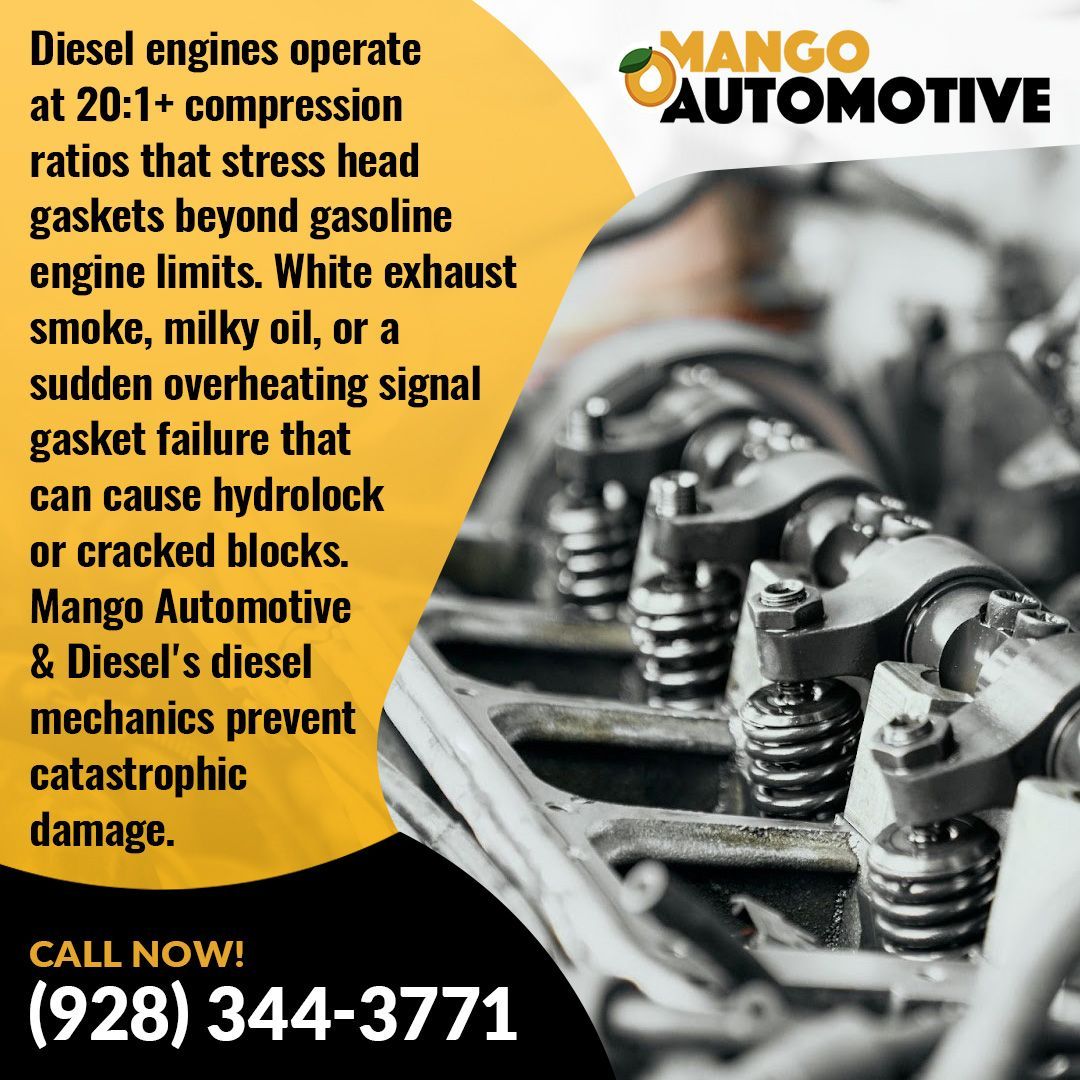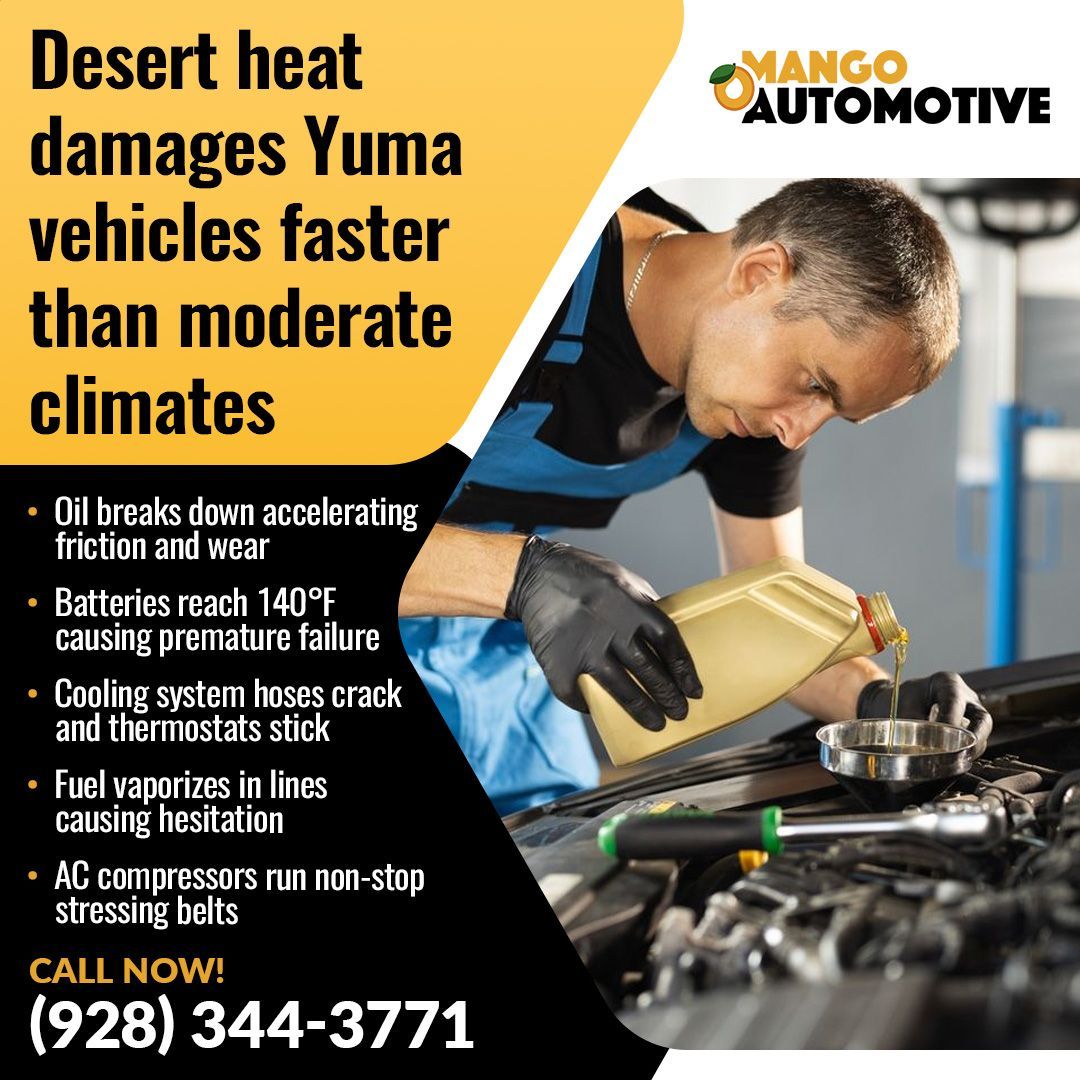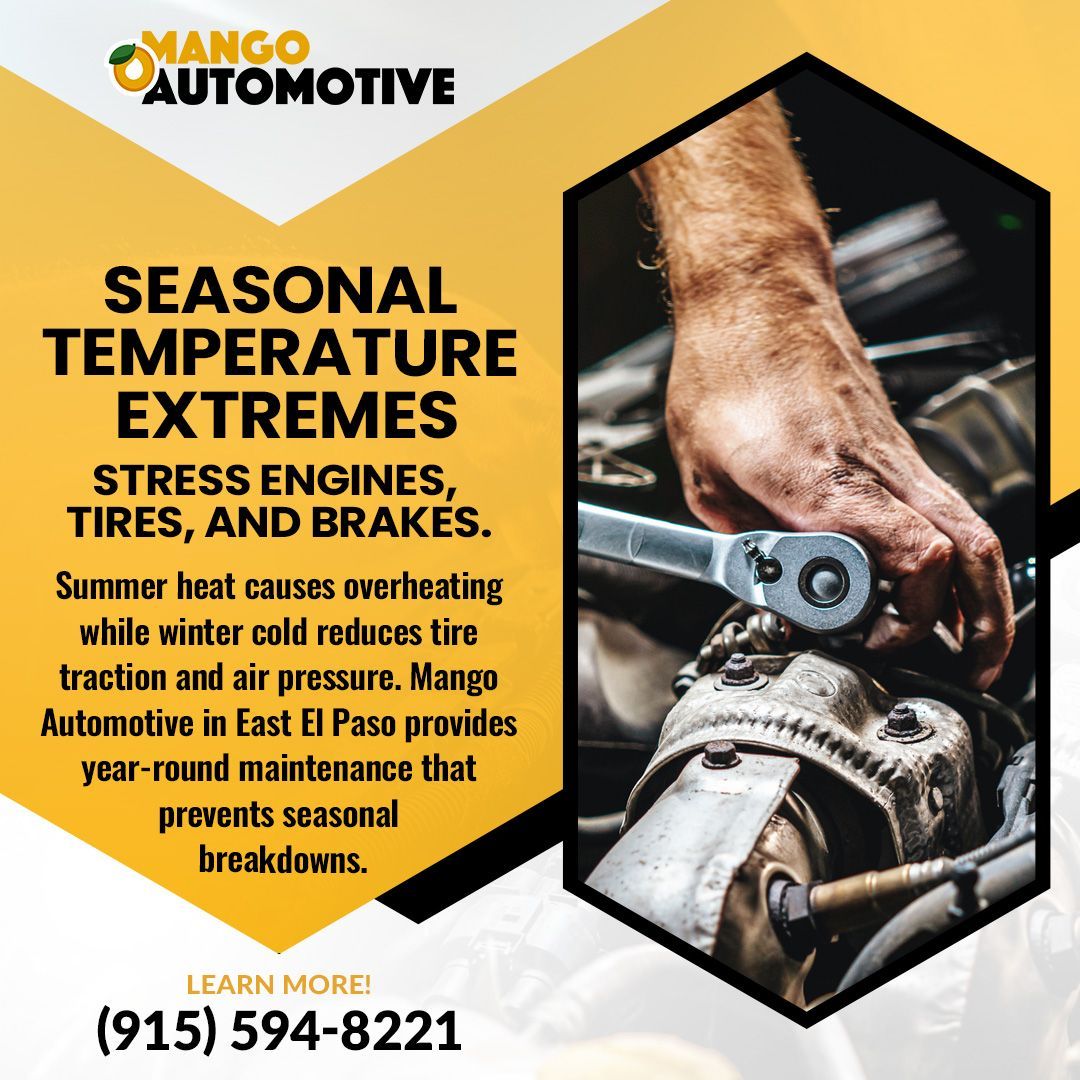The Most Common Auto Repairs After a Long Albuquerque Summer
Summer heat in Albuquerque tests every vehicle system through extreme temperatures, high altitude conditions, and intense UV exposure. Most cars need battery testing, cooling system inspection, fluid level checks, and brake evaluation after months of stress from temperatures exceeding 90°F.
The combination of sustained heat, low humidity, and high elevation accelerates component degradation in ways that drivers often don't notice until fall arrives. At
Mango Automotive, our technicians see specific patterns of damage after summer. These vehicles arrive at our
Eagle Ranch auto repair shop displaying the cumulative effects of three months under the high desert sun. Recognizing these common repair needs helps drivers prepare for the maintenance their vehicles require after the demanding summer season.

Impact of Summer on Vehicle Systems
Summer driving in Albuquerque exposes vehicles to conditions that stress multiple systems simultaneously. High temperatures affect fluid viscosity, rubber components lose flexibility, and electrical systems work harder to maintain performance. The city's 5,312-foot elevation adds another layer of complexity, as thinner air reduces cooling efficiency and increases engine workload.
Most summer-related failures don't announce themselves with noticeable symptoms. Instead, components degrade gradually over three months of heat exposure. A battery loses capacity week by week. Coolant breaks down incrementally, and rubber hoses develop microscopic cracks that eventually become leaks. By the end of summer, these accumulated stresses often reach critical thresholds.
Understanding which auto repairs are most common after summer helps drivers prioritize inspections and budget for necessary maintenance. Some issues require immediate attention to prevent safety hazards, while others can be scheduled during routine service intervals.
Battery and Electrical System Failures
Heat-Related Battery Degradation
Extreme heat degrades battery performance faster than cold weather. While most drivers associate dead batteries with winter, summer actually causes the damage that becomes apparent when temperatures drop. Heat accelerates the chemical reactions inside battery cells, causing electrolyte fluid to evaporate and internal components to corrode.
Albuquerque's summer temperatures regularly exceed 95°F, and under-hood temperatures can reach 200°F or higher. This environment shortens battery life from the typical four to five years down to three years or less. The AAA reports that heat-related
battery failures peak in late summer and early fall.
Warning Signs and Testing
Warning signs include slow engine cranking, dimming headlights, or electrical accessories that function inconsistently. Dashboard warning lights may illuminate intermittently. Corrosion around battery terminals appears as white or blue-green powder. Professional battery testing measures cold cranking amps (CCA) and overall capacity. A battery showing less than 50% capacity should be replaced before it fails completely.
Starter and Alternator Issues
Starter motor performance declines gradually with age and use. Professional testing checks how much power the starter draws and whether connections are working properly. When the starter requires too much power to turn the engine, it signals internal wear that will soon lead to failure.
Alternators experience similar heat-related stress. Lower voltage output indicates internal component wear or regulator failure, while higher voltage can damage sensitive electronic components throughout the vehicle.
Cooling System Stress and Breakdowns
Component Wear from Constant Operation
Cooling systems work continuously during summer months, circulating hot coolant hundreds of times per day. This constant operation reveals weaknesses in hoses, radiators, thermostats, and water pumps. The system must maintain engine temperature around 195-220°F while outside temperatures approach 100°F.
Radiator hoses deteriorate from repeated expansion and contraction. The rubber loses flexibility and develops small cracks that leak coolant. The radiator itself can develop leaks where plastic end tanks meet the aluminum core, a common failure point on vehicles with over 100,000 miles.
Thermostat and Water Pump Failures
Thermostats stick in the open or closed position after months of continuous cycling. A stuck-open thermostat causes the engine to run too cool, reducing fuel efficiency. A stuck-closed thermostat blocks coolant flow, leading to rapid overheating.
Water pumps develop leaks at the shaft seal or impeller damage that reduces coolant circulation. A failing water pump often produces a whining noise or visible coolant seepage near the front of the engine.
Coolant Condition and Replacement
Coolant degrades over time, losing its ability to transfer heat and protect against corrosion. Most manufacturers recommend coolant replacement every 30,000 to 50,000 miles, but Albuquerque's heat can accelerate this schedule. Fresh coolant contains additives that prevent rust and corrosion while maintaining proper boiling and freezing points.
Air Conditioning Performance Decline
Refrigerant Loss and System Efficiency
A/C systems lose approximately 5-10% of refrigerant capacity per year through normal operation. After a summer of constant use, many systems operate below peak efficiency. Refrigerant leaks, compressor wear, and condenser damage become apparent when the system struggles to maintain cabin temperature.
The refrigerants that modern vehicles use require specialized equipment for proper diagnosis and recharge. Simple refrigerant loss doesn't always indicate major problems, but persistent leaks suggest component replacement needs.
Compressor and Condenser Stress
The compressor endures the highest stress, cycling on and off hundreds of times during summer driving. Internal seals wear out, and clutch assemblies develop slippage. The condenser, mounted at the front of the vehicle, collects road debris, dust, and insects that block airflow and reduce cooling capacity.
Cabin Air Filter Restriction
Cabin air filters clog with dust and pollen during the summer months. A restricted filter reduces airflow through the vents, making the A/C system work harder to cool the cabin. This increased workload stresses the blower motor and can lead to premature failure. Filter replacement is a simple maintenance item that protects more expensive components.
Belt, Hose, and Rubber Component Deterioration
Serpentine Belt Wear
Rubber components lose flexibility and develop cracks after prolonged heat exposure. Serpentine belts drive the alternator, water pump, power steering pump, and A/C compressor. A single belt failure disables multiple systems simultaneously.
Modern EPDM (Ethylene Propylene Diene Monomer) belts don't show visible cracking like older belts, making regular inspection even more important. Most manufacturers recommend serpentine belt replacement every 60,000-100,000 miles.
Radiator and Heater Hose Failures
Radiator hoses carry coolant at temperatures near the boiling point. Summer heat accelerates the breakdown of rubber compounds, causing hoses to become spongy or develop surface cracks. A burst hose dumps coolant within seconds, causing immediate engine overheating. Heater hoses experience similar stress, though they carry less volume than radiator hoses. Power steering hoses operate under high pressure and develop leaks.
Vacuum Line Degradation
Vacuum hoses throughout the engine bay become brittle and crack. These small-diameter hoses control emissions systems, brake boosters, and various engine sensors. A single cracked vacuum hose can cause rough idling, poor fuel economy, and check engine lights.
Brake System Wear and Fluid Contamination
Pad and Rotor Condition
Brake systems work harder during summer months when extreme temperatures and frequent stops in traffic generate higher brake temperatures. Stop-and-go traffic in hot weather generates extreme brake temperatures, accelerating pad wear, and fluid degradation.
Brake pad life varies by driving conditions, but most pads require replacement between 25,000 and 70,000 miles. Visual inspection shows the remaining pad thickness. Pads with less than 3mm of friction material should be replaced promptly. Squealing or grinding noises indicate immediate replacement needs.
Brake rotors develop surface glazing or scoring from worn pads. Deep grooves, heat spots, or warping indicate rotor replacement or resurfacing needs. Warped rotors cause pedal pulsation during braking, a common complaint after summer driving.
Brake Fluid Moisture Absorption
Brake fluid testing measures moisture content and boiling point. Moisture absorption can reduce the boiling point of the fluid. Brake fluid that has absorbed more than 3% water should be replaced to prevent vapor lock and internal corrosion.
Albuquerque's monsoon season accelerates moisture absorption through the hygroscopic nature of brake fluid. This makes brake fluid testing particularly important for vehicles over three years old.
Addressing Multiple Post-Summer Issues
Many vehicles require several repairs simultaneously after Albuquerque's intense summer season. A car might need both battery replacement and cooling system hoses, or A/C repairs combined with brake fluid service. Our Albuquerque auto repair technicians often find that addressing multiple issues together saves time and reduces overall costs. For example, replacing a serpentine belt while performing cooling system work makes sense since both require similar access to engine components.
At Mango Automotive, we prioritize automotive repairs based on safety and urgency, helping you understand which issues need immediate attention and which can be scheduled for future service. This approach prevents small problems from becoming expensive emergencies while respecting your budget and timeline.
Albuquerque's Environmental Impact on Vehicles
High Altitude Effects
Albuquerque's location creates maintenance challenges found in few other cities. The elevation of 5,312 feet, combined with low humidity below 20% during summer, creates an environment that accelerates vehicle wear.
Thinner air at altitude contains less oxygen per cubic foot than sea level air. Air filters clog faster due to dust and fine particulate matter. The high desert environment generates airborne dust that enters the engine through the intake system.
Monsoon Season Challenges
Albuquerque's monsoon season from mid-June through September brings sudden humidity spikes and intense rainfall. These rapid weather changes stress vehicle systems adjusted to dry conditions. Moisture enters electrical systems through damaged weatherstripping or compromised seals.
Sudden temperature drops during monsoon storms create thermal shock in hot engine components. Temperature drop forces rapid contraction of metal parts, potentially revealing hairline cracks in exhaust manifolds or cylinder heads.
Albuquerque auto repair professionals who understand these unique environmental factors can diagnose problems that might be rare in other climates but are common in high desert conditions.
Post-Summer Inspection and Maintenance
Fluid Analysis and Testing
Complete vehicle inspection after summer addresses stress accumulated over months of extreme conditions. All vehicle fluids degrade faster in heat. Engine oil breaks down, losing its lubricating properties and accumulating contaminants. Transmission fluid oxidizes, turning dark and developing a burnt smell.
Oil life monitoring systems in modern vehicles track operating conditions and adjust change intervals accordingly, but manual inspection remains valuable for older vehicles. Fresh oil appears amber or light brown, while degraded oil turns black and feels gritty.
Coolant testing measures pH and freeze/boil protection. Test strips quickly show whether the coolant has lost its protective properties. Coolant that tests acidic promotes corrosion in aluminum engine components and should be flushed and replaced immediately.
Suspension Component Evaluation
Suspension components stress from summer road trips and accumulated mileage. Shock absorbers and struts gradually lose damping ability through normal wear. The bounce test provides a quick assessment - more than two bounces after pushing down firmly on each corner indicates worn dampers.
Ball joints and tie rod ends wear from road impacts and dust contamination. The play in these components affects steering precision. A professional inspection at an Albuquerque auto repair facility can check for looseness.
Professional Automotive Repair Services at Mango Automotive
Comprehensive Multi-Point Inspection
Mango Automotive provides post-summer vehicle assessment at our Eagle Ranch location. Our auto repair technicians understand how local conditions affect vehicles and inspect components based on summer stress factors specific to high desert environments. We examine battery capacity, cooling system integrity, fluid quality, brake system function, and electrical system performance.
Diagnostic Technology and Expertise
Modern vehicles contain dozens of computer modules that monitor systems continuously. Our diagnostic equipment reads data from engine control modules, transmission controllers, ABS systems, and climate control computers. This data reveals problems that haven't yet triggered warning lights or noticeable symptoms.
We provide recommendations prioritized by urgency. Our
automotive repair technicians distinguish between immediate safety concerns, repairs that should be scheduled within 30 days, and maintenance that can wait until the next service interval.
Warranty Coverage and Quality Standards
Our auto repair shop provides an industry-leading warranty of 60 months/60,000 miles (36 months/36,000 miles nationwide plus 24 months/24,000 miles at Mango Automotive locations). We use OEM (Original Equipment Manufacturer) or equivalent quality parts for all automotive repair work. Inferior parts may save money initially, but often fail prematurely, creating repeat repair costs and inconvenience.
Frequently Asked Questions
Can summer heat damage my car's computer systems?
Electronic control modules are designed to withstand under-hood heat, but prolonged exposure above 250°F can shorten their lifespan. Heat-related electronic failures typically manifest as intermittent problems like stalling, rough idling, or check engine lights that disappear when the vehicle cools. Parking in shade and maintaining proper cooling system function protects electronic components. Most computer modules last the vehicle's lifetime, but failures after 10-15 years can correlate with repeated extreme heat exposure.
How does the monsoon season affect post-summer repair priorities?
Monsoon humidity reveals weatherstripping and seal failures that remained hidden during the dry summer months. Water leaks into the cabin, trunk, or engine bay indicate compromised seals. Windshield wiper performance becomes critical during sudden downpours. Brake fluid contamination from moisture absorption occurs faster during the monsoon season, making brake fluid testing particularly important for vehicles over three years old.
Is it worth repairing an older vehicle after summer damage?
Auto repair decisions depend on total vehicle value, expected remaining service life, and repair costs. A $1,500 cooling system repair makes sense for a reliable vehicle worth $8,000 with proper maintenance. The same repair on a vehicle worth $2,000 with multiple other problems may not justify the investment. Our Eagle Ranch auto repair technicians provide honest assessments of repair value versus replacement options, helping you make informed decisions without pressure.
What maintenance items are more important in Albuquerque versus humid climates?
Cooling system maintenance, air filter replacement, and UV-related rubber component inspection require more attention in Albuquerque's high desert climate. Humid climates accelerate rust and corrosion, while Albuquerque's dry air focuses wear on heat-related components and rubber seals. Battery life averages one year shorter in desert heat compared to moderate climates.
Can I perform post-summer maintenance myself, or should I visit an auto repair shop?
Basic tasks like checking fluid levels and topping off windshield washer fluid are safe for DIY maintenance. However, cooling system pressure testing, brake fluid moisture testing, and electrical system diagnostics require specialized equipment found at professional
auto repair shops. A/C refrigerant service requires EPA certification and proper equipment. Professional inspection catches problems that aren't visible during casual examination.
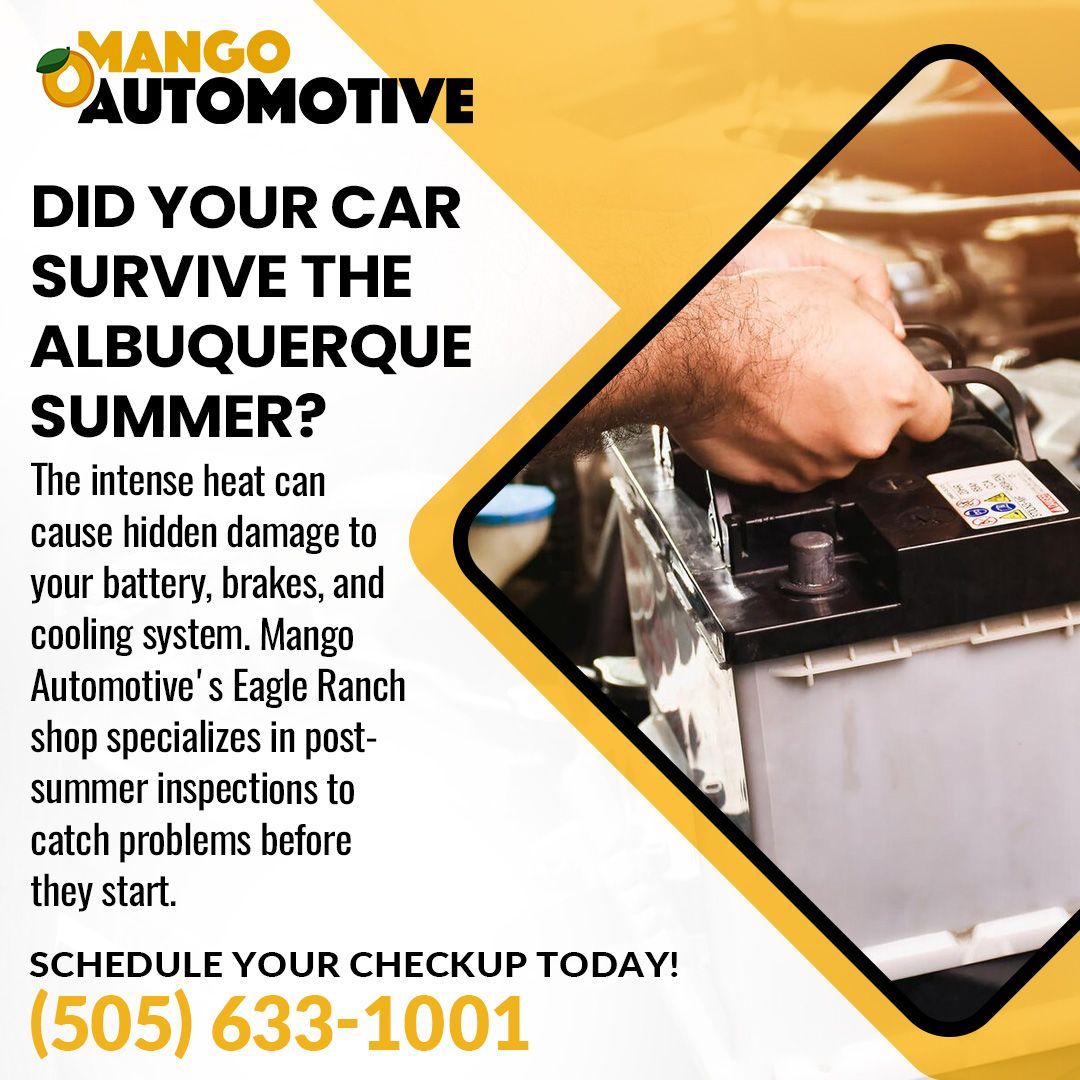
Get Expert Auto Repair in Albuquerque Today
Don't wait for warning signs to become breakdowns. The stress your vehicle accumulated during Albuquerque's summer demands professional evaluation before fall and winter conditions arrive. At Mango Automotive, we use advanced diagnostic tools and local experience to identify problems specific to high desert driving. Post-summer inspections protect your investment by catching problems early when repairs cost less and prevent secondary damage.
Contact Mango Automotive at
(505) 633-1001 to schedule your service appointment. Our Eagle Ranch auto repair team provides honest assessments and clear explanations of any needed repairs. Experience the difference that professional automotive repair makes for your vehicle's reliability and longevity.


